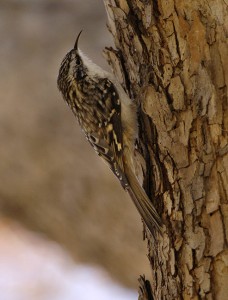The Dawn Song of Brown Creeper

The dawn chorus. You love it or you hate it.
If you hate it, it’s probably because you don’t appreciate being roused from sleep by a vigorous burst of birdsong in the early morning darkness. This is a common sentiment in the parts of the world where we now think of nature as an interruption of our experience, rather than the medium through which it flows.
If you love the dawn chorus, it may be for its music, its regularity, its symbolism. Or just for the happy reminder that nature survives, at least in some form, right outside the window.
I love the dawn chorus in part because it contains songs that you can hear at no other time of day. A number of North American birds sing dawn songs unlike anything they say after sunrise. I’ve written here about several: Violet-green Swallow, American Robin, Cassin’s Kingbird, Cordilleran and Pacific-slope Flycatchers. But if you had asked me six months ago whether Brown Creeper had a distinctive dawn song, I would have told you no.
Here’s the typical song of the Brown Creeper — a short high-pitched warble, repeated without much variation:
Most sources say that this song can be heard at any time of day. Some observers have reported hearing it as early as 4:50 in the morning, but it doesn’t seem to be given regularly or repeatedly at that hour. Instead, most Brown Creepers apparently start their day with utterances like this one:

(Click here to listen to this recording at the Macaulay Library website.)
Two “tseew” notes followed by two “trill” calls may not sound like much of a dawn song, especially since the “tseew” and the “trill” are two of the common calls given by Brown Creepers throughout the day — the “tseew” mostly in alarm, the “trill” in a variety of situations. But this is not just a string of calls mixed together at random. The calls comprise a repeated and stereotyped sequence: “tseew tseew trill trill… tseew tseew trill trill… tseew tseew trill trill… tseew tseew trill trill.” The exact pattern varies from one bird to the next, but each individual adheres to its own fairly rigid syntax and rhythm. They’re not just calling, they’re singing.
Brown Creepers, unlike many other species, appear to transition gradually from dawn singing patterns into daytime singing patterns. They start out with these stereotyped patterns of “tseets” and “trills” and then, as the sun rises, they start tossing in “regular” song strophes more and more frequently. Here’s a sunrise recording from New Jersey in which the dawn songs and the day songs are alternated. And here’s a dawn-singing bird from Arizona that introduces each strophe of day song with components of the dawn song:
I have a recording, also from Arizona, of a Brown Creeper doing something similar as late as 9:00 AM. Later in the day, the dawn song patterns apparently disappear altogether.
More study of Brown Creeper dawn-singing is needed. For example, it would be interesting to determine patterns of individual and geographic variation, and to find out whether and how birds respond to playback of the dawn song. If you live near Brown Creepers, it wouldn’t be too difficult to find answers to some of these questions next spring — as long as you’re willing to rise before the birds.